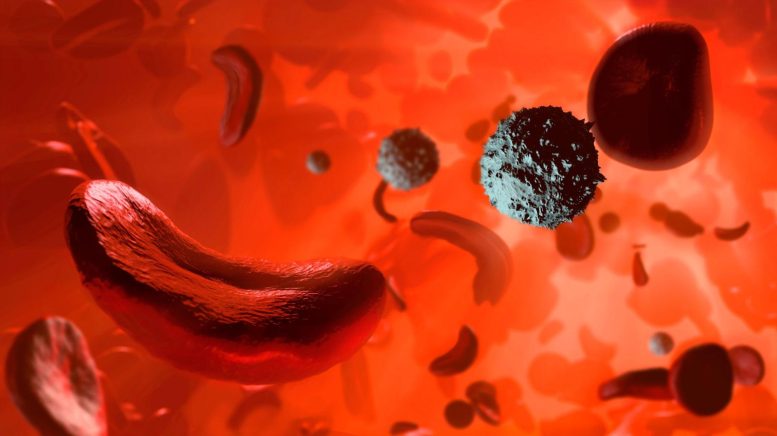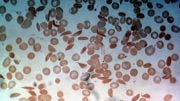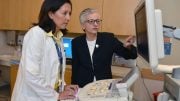
A new analysis shows that sickle cell disease is a leading cause of death across multiple age groups and is most prevalent in sub-Saharan Africa, where newborn screening and treatment access are urgently needed. Rising mortality rates since 2000 are primarily driven by population growth in South Asia and sub-Saharan Africa.
The hereditary illness affects 8 million individuals, disproportionately impacting young adults, adolescents, and children.
A recent study indicates that the death toll attributed to sickle cell disease is likely 11 times higher than what mortality records alone suggest. Not only is the condition often underdiagnosed, but it also heightens the risk of various complications such as infections, strokes, cardiac issues, kidney dysfunction, and complications during pregnancy.
This implies that a healthcare provider treating a patient with sickle cell disease who passes away due to a stroke might be unaware that the individual had the condition, or may not recognize that sickle cell disease can cause stroke. As a result, the doctor may not list sickle cell disease as a cause of death for that individual.
When other sources of data on prevalence and birth incidence were combined with mortality data in epidemiological modeling, in 2021, the “total mortality burden” of sickle cell disease was 373,000 deaths, compared to 34,600 sickle-cell-only deaths, or “cause-specific deaths.” The increase was especially pronounced in South Asia and sub-Saharan Africa, where the fatality figures were 67 times higher and nine times higher, respectively.
The study analyzed global health data from 2000 to 2021 and was recently published in The Lancet Haematology journal. The research is part of the Global Burden of Disease 2021 study coordinated by the Institute for Health Metrics and Evaluation (IHME) at the University of Washington’s School of Medicine.
“Our research reveals the stark reality that sickle cell disease is far deadlier than its textbook description,” says senior author Dr. Nicholas Kassebaum, Adjunct Associate Professor at IHME. “The number of babies born with sickle cell disease is rising, which means a very difficult early childhood. Patients are more susceptible to infections and other severe conditions, so early detection is key for treatment.”
In 2021, half a million babies were born with sickle cell disease, and more than three-quarters of these births were in sub-Saharan Africa. Under the analysis of total mortality burden (including secondary conditions), sickle cell disease was the 12th leading cause of death globally for children under the age of 5 years. However, total sickle cell disease mortality burden was among the top three causes of death in Portugal, Jamaica, Libya, Oman, and San Marino.
“Improved data collection is critical to tracking progress on sickle cell disease. In order to overcome this data limitation, instead of using mortality data alone to estimate total sickle cell disease deaths, we used a mathematical algorithm that also takes input data from birth incidence, survival over time, and prevalence, and ensures these measures are internally consistent,” explains Azalea Thomson, first author and IHME researcher on the Neonatal and Child Health Team. “By making use of all available data, we were able to strengthen our understanding of the true burden of sickle cell disease and better contextualize it alongside other leading causes of death. For example, in 2021, in kids under 5 years in sub-Saharan Africa, total sickle cell disease deaths exceeded those from malnutrition, measles, or syphilis.”
The research also underscores the need for policymakers and public health advocates to address the largely underrecognized burden of sickle cell disease. Universal newborn screening, case monitoring through public registries, and early intervention treatment can alleviate suffering for some 8 million people living with sickle cell disease.
“Universal newborn screening is essential for early diagnosis and management of sickle cell disease,” says Dr. Theresa McHugh, scientific writer at IHME who focuses on neonatal and child health. “In low- and middle-income countries, the newborn screening process is fragmented. In the US, newborn screening is universal, but a national registry does not yet exist. Increased global awareness and adoption of health policies that expand neonatal screening and make treatment more accessible will go a long way in improving health outcomes.”
Reference: “Global, regional, and national prevalence and mortality burden of sickle cell disease, 2000–2021: a systematic analysis from the Global Burden of Disease Study 2021” by Azalea M Thomson, Theresa A McHugh, Assaf P Oron, Corey Teply, Nikhil Lonberg, Victor Vilchis Tella, Lauren B Wilner, Kia Fuller, Hailey Hagins, Richard Gyan Aboagye, Melka Biratu Aboye, Eman Abu-Gharbieh, Ahmed Abu-Zaid, Isaac Yeboah Addo, Bright Opoku Ahinkorah, Aqeel Ahmad, Saif Aldeen S AlRyalat, Hubert Amu, Aleksandr Y Aravkin, Judie Arulappan, Maha Moh’d Wahbi Atout, Ashish D Badiye, Sara Bagherieh, Maciej Banach, Morteza Banakar, Mainak Bardhan, Amadou Barrow, Deriba Abera Bedane, Isabela M Bensenor, Akshaya Srikanth Bhagavathula, Pankaj Bhardwaj, Prarthna V Bhardwaj, Ajay Nagesh Bhat, Zulfiqar A Bhutta, Mariah Malak Bilalaga, Jessica Devin Bishai, Saeid Bitaraf, Archith Boloor, Muhammad Hammad Butt, Vijay Kumar Chattu, Dinh-Toi Chu, Omid Dadras, Xiaochen Dai, Bardia Danaei, Anh Kim Dang, Fitsum Wolde Demisse, Meghnath Dhimal, Daniel Diaz, Shirin Djalalinia, Deepa Dongarwar, Muhammed Elhadi, Mohamed A Elmonem, Christopher Imokhuede Esezobor, Farshid Etaee, Oghenowede Eyawo, Adeniyi Francis Fagbamigbe, Ali Fatehizadeh, Lisa M Force, William M Gardner, Kazem Ghaffari, Paramjit Singh Gill, Mahaveer Golechha, Pouya Goleij, Vivek Kumar Gupta, Hamidreza Hasani, Treska S Hassan, Mohammed Bheser Hassen, Segun Emmanuel Ibitoye, Adalia I Ikiroma, Chidozie C D Iwu, Peter Bai James, Shubha Jayaram, Rime Jebai, Ravi Prakash Jha, Nitin Joseph, Farnaz Kalantar, Himal Kandel, Ibraheem M Karaye, Woldeteklehaymanot Dagne Kassahun, Imteyaz A Khan, Shaghayegh Khanmohammadi, Adnan Kisa, Farzad Kompani, Kewal Krishan, Iván Landires, Stephen S Lim, Preetam Bhalchandra Mahajan, Soleiman Mahjoub, Azeem Majeed, Bishnu P Marasini, Haftu Asmerom Meresa, Tomislav Mestrovic, Sonica Minhas, Awoke Misganaw, Ali H Mokdad, Lorenzo Monasta, Ghulam Mustafa, Tapas Sadasivan Nair, Sreenivas Narasimha Swamy, Hasan Nassereldine, Zuhair S Natto, Muhammad Naveed, Biswa Prakash Nayak, Jean Jacques Noubiap, Taylor Noyes, Chisom Adaobi Nri-ezedi, Vincent Ebuka Nwatah, Chimezie Igwegbe Nzoputam, Ogochukwu Janet Nzoputam, Osaretin Christabel Okonji, Adeyinka Omoniyi Onikan, Mayowa O Owolabi, Jay Patel, Siddhartha Pati, Shrikant Pawar, Ionela-Roxana Petcu, Frédéric B Piel, Ibrahim Qattea, Mehran Rahimi, Mosiur Rahman, Salman Rawaf, Elrashdy Moustafa Mohamed Redwan, Nazila Rezaei, Basema Saddik, Umar Saeed, Fatemeh Saheb Sharif-Askari, Abdallah M Samy, Austin E Schumacher, Elaheh Shaker, Adithi Shetty, Migbar Mekonnen Sibhat, Jasvinder A Singh, Muhammad Suleman, Dev Ram Sunuwar, Mindy D Szeto, Jacques JL Lukenze Tamuzi, Nathan Y Tat, Birhan Tsegaw Taye, Mohamad-Hani Temsah, Muhammad Umair, Sahel Valadan Tahbaz, Cong Wang, Nuwan Darshana Wickramasinghe, Arzu Yigit, Vahit Yiğit, Ismaeel Yunusa, Burhan Abdullah Zaman, Moein Zangiabadian, Peng Zheng, Simon I Hay, Mohsen Naghavi, Christopher J L Murray and Nicholas J Kassebaum, 15 June 2023, The Lancet Haematology.
DOI: 10.1016/S2352-3026(23)00118-7
The study was funded by the Bill & Melinda Gates Foundation. The study team included researchers from IHME and GBD 2021 collaborators from around the world.









Be the first to comment on "Startling New Research: Sickle Cell Disease Is 11 Times More Deadly Than Previously Thought"